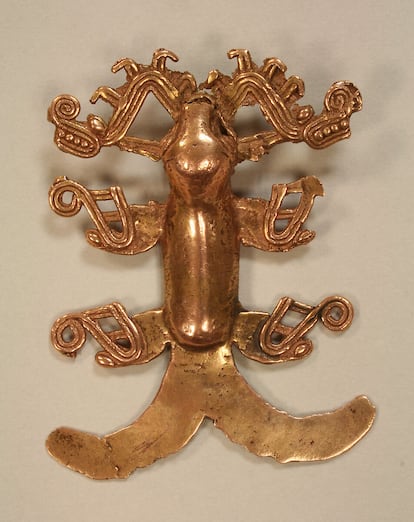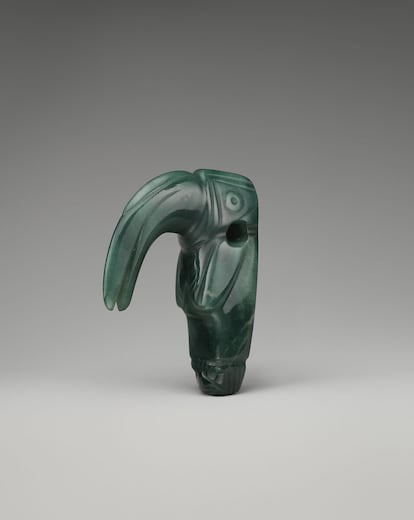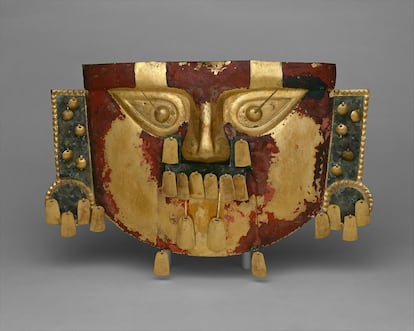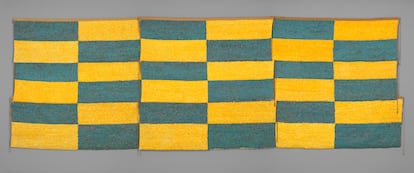‘Teotihuacán was the multiethnic and multicultural city that New York is today’: A tour of the MET’s new Michael C. Rockefeller Wing
EL PAÍS received exclusive access to the latest developments and updates in the Ancient American Art section of the Metropolitan Museum of Art in New York, which reopened on May 31, after four years of renovations

Laura Filloy Nadal finds it easier to explain the world if she has an object in front of her.
The 58-year-old Mexican is an archeologist, curator and restorer. Since 2022, she’s been curating the Michael C. Rockefeller Wing of the Metropolitan Museum of Art (MET) in New York City. This particular wing houses the museum’s collection of Ancient American Art. It reopened on Saturday, May 31, after a four-year-long renovation.
The Michael C. Rockefeller Wing — which opened in 1982 — houses more than 1,800 artifacts from the peoples of sub-Saharan Africa, the Americas and Oceania, from 3000 BCE to the present. Until 2021, however, the Americas area remained almost untouched. The narrative that once connected the pieces had become outdated and no longer answered the questions of a present in constant flux, as most of the discoveries and advances in the understanding of Ancient American Art came after the wing’s original inauguration.
Flipping the map 180 degrees
In the days before the gallery’s reopening, Filloy Nadal walked with EL PAÍS through the 43,000-square-foot area, filled with morning light. She and curator Joanne Pillsbury have been responsible for ensuring that the discoveries, data and knowledge fit into a coherent story and accurate map.
The direction of the journey is important. Flipping the map 180 degrees — which has been done on the gallery’s main screen — is necessary. The Americas are lying down. The map is so powerful that it’s necessary to point it out and ask why such a choice has been made. “It’s part of the narrative: you can see the world from any position you want to see it… and that’s precisely what allows us to understand it,” Filloy Nadal replies.
The animated map represents the movement of the first settlers. On the screen, the arrows don’t go from north to south, but from left to right, transforming according to the social and political systems — borders, kingdoms, countries — that have been agreed upon in the history of human decisions, almost all mediated by force and tragedy.
On the other hand, everything in the room says something about how humans migrate and have always migrated. It tells a story about the Americas that is centered around human movement. “It’s a place where we can look at ourselves,” the curator suggests.
“We’re seeing how different cultures emerge, and we’re going to understand that they communicated, that there were interactions we didn’t understand before,” says Filloy Nadal. “For example, along the coasts: between Ecuador and western Mexico. And we can see how borders have retreated or expanded over time. There are political borders, but they have nothing to do with the distribution of peoples. Oftentimes, the same culture transcends a contemporary border.”
“Much later, in the 20th century, the movement is the other way around, which feeds into the cultural mosaic of, for example, the United States or New York,” she continues. “Our goal is always to return to where we are, to this land, which is New York, where 27% of the population is Latino.”
But long before New York existed, there was Teotihuacán, located about 30 miles northeast of modern-day Mexico City. And that’s where the gallery’s journey begins. “There were people living there who came from all corners of Mesoamerica. Merchants, artisans, people who migrated and brought their customs with them. Teotihuacán was the multiethnic and multicultural city that New York is today.”
Filloy Nadal knows the questions in advance and has a clear narrative. She has selected a series of pieces from the gallery that together build a story resembling a lecture on Ancient American art.

“This is a piece that, I think, speaks volumes about globalization, about that cultural exchange that has always existed. It’s very interesting, because it’s a 16th-century ceramic lebrillo [earthenware bowl],” the curator says. “This lebrillo was used by the Arabs and was very common in Spain. What’s interesting about this piece is that it was made in the city of Puebla, Mexico. But if you look at the colors and motifs, it’s not like the kind you usually see in Spain. The blue color speaks to the influence that eastern China had on Mexico. And, in the center, we see that these motifs aren’t made by a European hand, but by an Indigenous one. We see a double-headed eagle, which is the eagle on the coat of arms of the Habsburg royal family, who ruled or governed New Spain. In a single vessel, we have the whole world of the 16th century,” she explains.
Migration, metallurgy and trade
When asked what do these objects reveal about the movements and relationships between the peoples of the Americas and the world, the curator replies, each specific case contributes to the narrative.

Take the pendant made by the Indigenous Chiriquí people of modern-day Panama, for example. Why would a curator place a Chiriquí piece in the Mayan world? The piece was made by a Chiriquí artist. But someone from the area that is now [probably] Panama — who considered it to be a valuable object — took it to Yucatán and left it in Chichén Itzá [in Mexico], which, at the time, was a place of pilgrimage where offerings were brought.
“You have to imagine these life stories: someone walking to carry this object or passing this object from hand to hand, so that it reaches a sacred place, which is very different from the place where it originated,” Filloy Nadal notes.

The curator moves on to the Costa Rican region, where there are carefully-carved jade pieces. The Olmecs, Mexica, Teotihuacan and Maya peoples walked miles upon miles to search for the mineral in the Motagua River, in present-day Guatemala. Meanwhile, the populations of southern Costa Rica — who lived near the river — ignored the stone entirely. Instead, they looked south. They were interested in technology and goldsmithing, which began in South America 2,000 years earlier than in the rest of the continent.
“The beautiful thing about the MET’s gold collection is that it’s a synoptic collection. There are pieces from different cultures and time periods. Perhaps museums in the countries of origin have large gold collections, but the pieces don’t come from other places.”

The collection also draws parallels between the two empires that coexisted at the time of Spain’s arrival — the Aztecs and the Incas — and their technological knowledge. “This mastery of techniques — such as the mixing and alloying of metals, which took much longer to master in Europe — is impressive in terms of innovation in metallurgy.”
On the screen, an owl appears. It’s the same as the one on display in the showcase, on a shield made of gold. But the digital image shows no corrosion and is in motion: the owl’s wings flap.
“You have to imagine that the opponent — when in battle — saw the owl as if it were coming at them," says the curator. “And, thanks to these digital tools, we can explain a bit about why these objects looked like they did in the past, when they were resplendent. And how they were used.”
Textiles valued more than gold
Although gold typically has the highest value among metals, Filloy Nadal recalls that, in the pre-Hispanic world, in terms of values, meanings and materials, textiles were valued far more than gold.
The textile portion of the exhibit is in semi-darkness. But the dyes of each object have their own distinct light. This space is very innovative; the MET is one of the museums that has shown the greatest interest — and has invested the most money — in the acquisition of textiles, primarily because New York established itself as a pioneering city in the industry. Since its inception, the MET has created a kind of unprecedented textile library.

One wall of the room is completely covered in panels, displaying more than 250,000 blue and yellow macaw feathers. And Filloy Nadal has information at her disposal that few visitors ask about: “The people at this museum — in collaboration with other institutions — have conducted a series of stable isotope studies to find out what the birds ate. They found that some ate strawberries — they were free-roaming macaws — but others were fed corn. And corn is a crop that relies on humans. So, now we know that they were keeping birds in captivity or semi-captivity.”

There are also two unkus — or tunics — on display. The unku is an upper-body garment made of red, white and black threads, with a checkerboard pattern. It may have taken more than a thousand hours to manufacture. Such is its mastery that its back is exactly the same as its front. “It’s very interesting, because chroniclers described how some members of the emperor’s court were dressed in this type of shirt, with alternating black-and-white checks.”
The unku is also an answer to the general question that resonates throughout the permanent exhibit’s story: “Returning to the theme of borders, this type of tunic has been found in Peru, Argentina, Chile and Bolivia. In other words, the extent of the ancient Tahuantinsuyu — the name that the Incas gave to their empire,” Filloy Nadal affirms.
The conclusion of the tour is simple: migration is something we have always done, and something we will never stop doing. And thanks to it, there is change, evolution, and creation.
“You migrate for your own story. And you leave many things behind, but you also bring many other things with you. Wherever you go, you have an impact and transformation. And that’s something that must be appreciated,” Filloy Nadal concludes.
After completing the journey, you’re left with the feeling that migrating — and being in New York, a city of immigrants — is a continuation of that very story.
Sign up for our weekly newsletter to get more English-language news coverage from EL PAÍS USA Edition
Tu suscripción se está usando en otro dispositivo
¿Quieres añadir otro usuario a tu suscripción?
Si continúas leyendo en este dispositivo, no se podrá leer en el otro.
FlechaTu suscripción se está usando en otro dispositivo y solo puedes acceder a EL PAÍS desde un dispositivo a la vez.
Si quieres compartir tu cuenta, cambia tu suscripción a la modalidad Premium, así podrás añadir otro usuario. Cada uno accederá con su propia cuenta de email, lo que os permitirá personalizar vuestra experiencia en EL PAÍS.
¿Tienes una suscripción de empresa? Accede aquí para contratar más cuentas.
En el caso de no saber quién está usando tu cuenta, te recomendamos cambiar tu contraseña aquí.
Si decides continuar compartiendo tu cuenta, este mensaje se mostrará en tu dispositivo y en el de la otra persona que está usando tu cuenta de forma indefinida, afectando a tu experiencia de lectura. Puedes consultar aquí los términos y condiciones de la suscripción digital.

